Search the Special Collections and Archives Portal
Search Results
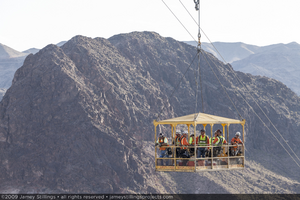
Photograph of ironworkers in a manbasket during construction of Mike O'Callaghan-Pat Tillman Memorial Bridge, Nevada-Arizona border, July 1, 2009
Date
2009-07-01
Archival Collection
Description
Photographer's notes: "Ironworkers and manbasket, July 1, 2009." Site Name: Mike O'Callaghan-Pat Tillman Memorial Bridge
Image
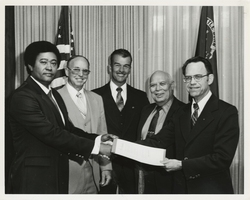
Photograph of group signing proclamation for City of North Las Vegas Crime Prevention, North Las Vegas, Nevada, April 17, 1982
Date
1982-04-17
Archival Collection
Description
Group signing proclamation for City of North Las Vegas Crime Prevention Week April 11- April 17, 1982. Pictured L-R: Al Gleghorn, Director of Neighborhood Watch Program; Dale Huntsman, Chairman of Crime Prevention Task Committee; William Tharp, North Las Vegas Chief of Police; Nick Janise, Assistant Director of Neighborhood Watch Program; James Seastrand, Mayor of the City of North Las Vegas.
Image
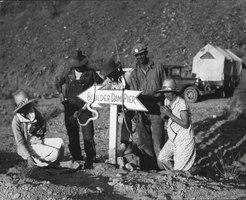
Photograph of people standing at a sign for the Boulder Dam Pier that has rattlesnakes hanging from it, Boulder City, Nevada, April 18, 1931
Date
1931-04-18
Archival Collection
Description
A black and white image of men and women at a sign for the Boulder Dam Pier. The sign has rattlesnakes draped over it.
Image
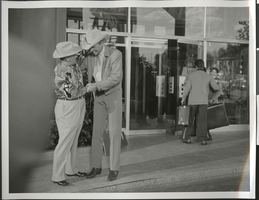
Photograph of Jake Friedman and Dan Dailey during the filming of "Meet Me in Las Vegas," Las Vegas, Nevada, circa 1955-1956
Date
1955 to 1956
Archival Collection
Description
Jake Friedman, co-owner of the Sands Hotel (left), shakes hands with actor Dan Dailey during the filming of the motion picture "Meet Me In Las Vegas," which was filmed primarily at the Sands.
Image
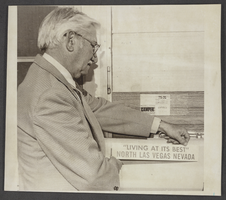
Photograph of Ted Travers, North Las Vegas Chamber of Commerce President, with a new bumper sticker promoting the city, North Las Vegas, Nevada, March 31, 1976
Date
1976-03-31
Archival Collection
Description
North Las Vegas Chamber of Commerce president Ted Travers puts a new North Las Vegas bumper sticker on a camper, March 3, 1976. The stickers were designed to promote North Las Vegas, Nevada's third largest city.
Image
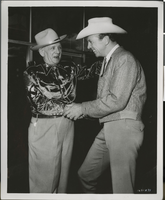
Photograph of Jake Friedman and Dan Dailey during the filming of "Meet Me in Las Vegas," Las Vegas, Nevada, circa 1955-1956
Date
1955 to 1956
Archival Collection
Description
Typed description on back of photograph: "WELCOME… to Las Vegas. On location at the famed desert resort, Dan Dailey gets a warm welcome from Jake Friedman, proprietor of the internationally known Sands Hotel. "Meet Me in Las Vegas" is M-G-M's colorful invitation to sparkling entertainment, set in the fabulous desert resort with an outstanding cast headed by Dan Dailey, Cyd Charisse, Liliane Montevecchi, Agnes Moorehead, Oscar Karlweis, Lili Darvas, and Paul Henreid. Adding their diversified talents to the CinemaScope musical are guest stars Jerry Colonna, Sammy Davis, Jr., Lena Horne, Frankie Laine, Peter Lorre, Frank Sinatra, the Slate Brothers, and Japanese singing discovery Mitsuko Sawamura. Nicholas Brodszky and Sammy Cahn wrote the music, with Joe Pasternak producing and Roy Rowland directing."
Image

Photograph of Blanche Zucker, Sidney Saltz and Colette Saltz at a WE CAN benefit, Union Plaza Hotel, Las Vegas, Nevada, 1984
Date
1984
Archival Collection
Description
L-R: Blanche Zucker, Sidney and Colette Saltz at the WE CAN "Love Ya Child" benefit at the Union Plaza Hotel, Las Vegas. WE CAN (Working to Eliminate Child Abuse and Neglect) was a chapter of the National Committee to Prevent Child Abuse (later Prevent Child Abuse America). Blanche Zucker was the president of WE CAN. Site Name: Union Plaza Hotel and Casino (Las Vegas, Nev.) Street Address: 1 South Main Street
Image
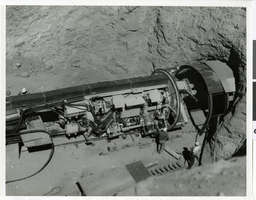
Photograph of the outlet portal showing the mole preparing to walk into the tunnel on the Las Vegas River Mountain Project, Las Vegas, Nevada, circa 1968-1971
Date
1968 to 1971
Archival Collection
Description
A close-up view looking down from the left side of the outlet portal showing the mole preparing to walk into the tunnel. Three unidentified men can be seen working near the mole. The first stage of construction was completed between 1968-1971, and is comprised of a main aqueduct, a 3.78 mile tunnel through the River Mountains, eight pumping plants, and 31.4 miles of pipeline. This stage has a peaking capacity of 26.7 million cubic feet of potable water per day. The second stage enlarged the first stage system by expanding some of the existing facilities. New features included five pumping plants, the second barrel to the main aqueduct, and about 30 miles of pipeline and laterals with surge tanks, regulating tanks, and other delivery facilities. In conjunction with this stage, the State of Nevada enlarged and modified the Alfred Merritt Smith water treatment facilities to accommodate additional water supplies. The River Mountains Tunnel was constructed to full capacity in the first stage, and the Saddle Island intake facilities were oversized to accommodate both stages. The aqueduct system has a peaking capability of 53.4 million cubic feet of water per day. The River Mountains Tunnel was constructed during the first stage to accommodate second stage expansion. It is 3.78 miles long and was excavated through the River Mountains, which lie between Las Vegas Valley and Lake Mead. The concrete-lined tunnel has an inside diameter of 121.5 inches, and a maximum capacity of 608 cfs. The SNWA also constructed a larger tunnel, parallel to the River Mountains Tunnel for further expansion. The River Mountains Tunnel is used to convey raw water from Lake Mead to the River Mountains Water Treatment Facility that SNWA constructed near Henderson, NV. The River Mountains Facility, which began delivering treated water in October 2002, treats up to 300 million gallons of water per day, and was designed so it can expand to meet Southern Nevada's needs. In the future, the River Mountains facility will be able to treat up to 600 million gallons of water a day. This facility provides additional reliability and capacity to Southern Nevada's municipal water treatment and distribution capabilities.
Image
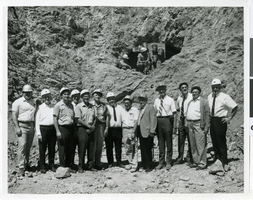
Photograph of Key federal, state and contractor representatives who were on hand when the mole broke through the tunnel, Las Vegas, Nevada, 6-26-69
Date
1969-06-26
Archival Collection
Description
A group of 13 key federal, state and contractor representatives who were on hand when the mole broke through the tunnel on 6-26-69. Two unidentified workers are visible above them with the "mole." The first stage of construction was completed between 1968-1971, and is comprised of a main aqueduct, a 3.78 mile tunnel through the River Mountains, eight pumping plants, and 31.4 miles of pipeline. This stage has a peaking capacity of 26.7 million cubic feet of potable water per day. The second stage enlarged the first stage system by expanding some of the existing facilities. New features included five pumping plants, the second barrel to the main aqueduct, and about 30 miles of pipeline and laterals with surge tanks, regulating tanks, and other delivery facilities. In conjunction with this stage, the State of Nevada enlarged and modified the Alfred Merritt Smith water treatment facilities to accommodate additional water supplies. The River Mountains Tunnel was constructed to full capacity in the first stage, and the Saddle Island intake facilities were oversized to accommodate both stages. The aqueduct system has a peaking capability of 53.4 million cubic feet of water per day. The River Mountains Tunnel was constructed during the first stage to accommodate second stage expansion. It is 3.78 miles long and was excavated through the River Mountains, which lie between Las Vegas Valley and Lake Mead. The concrete-lined tunnel has an inside diameter of 121.5 inches, and a maximum capacity of 608 cfs. The SNWA also constructed a larger tunnel, parallel to the River Mountains Tunnel for further expansion. The River Mountains Tunnel is used to convey raw water from Lake Mead to the River Mountains Water Treatment Facility that SNWA constructed near Henderson, NV. The River Mountains Facility, which began delivering treated water in October 2002, treats up to 300 million gallons of water per day, and was designed so it can expand to meet Southern Nevada's needs. In the future, the River Mountains facility will be able to treat up to 600 million gallons of water a day. This facility provides additional reliability and capacity to Southern Nevada's municipal water treatment and distribution capabilities.
Image
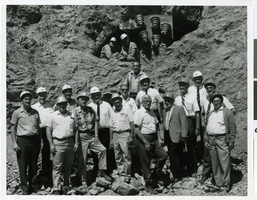
Photograph of Key federal, state and contractor representatives who were on hand when the mole broke through the tunnel, Las Vegas, Nevada, 6-26-69
Date
1969-06-26
Archival Collection
Description
A group of 16 key federal, state and contractor representatives who were on hand when the mole broke through the tunnel on 6-26-69. Two unidentified workers are visible above them with the "mole." The first stage of construction was completed between 1968-1971, and is comprised of a main aqueduct, a 3.78 mile tunnel through the River Mountains, eight pumping plants, and 31.4 miles of pipeline. This stage has a peaking capacity of 26.7 million cubic feet of potable water per day. The second stage enlarged the first stage system by expanding some of the existing facilities. New features included five pumping plants, the second barrel to the main aqueduct, and about 30 miles of pipeline and laterals with surge tanks, regulating tanks, and other delivery facilities. In conjunction with this stage, the State of Nevada enlarged and modified the Alfred Merritt Smith water treatment facilities to accommodate additional water supplies. The River Mountains Tunnel was constructed to full capacity in the first stage, and the Saddle Island intake facilities were oversized to accommodate both stages. The aqueduct system has a peaking capability of 53.4 million cubic feet of water per day. The River Mountains Tunnel was constructed during the first stage to accommodate second stage expansion. It is 3.78 miles long and was excavated through the River Mountains, which lie between Las Vegas Valley and Lake Mead. The concrete-lined tunnel has an inside diameter of 121.5 inches, and a maximum capacity of 608 cfs. The SNWA also constructed a larger tunnel, parallel to the River Mountains Tunnel for further expansion. The River Mountains Tunnel is used to convey raw water from Lake Mead to the River Mountains Water Treatment Facility that SNWA constructed near Henderson, NV. The River Mountains Facility, which began delivering treated water in October 2002, treats up to 300 million gallons of water per day, and was designed so it can expand to meet Southern Nevada's needs. In the future, the River Mountains facility will be able to treat up to 600 million gallons of water a day. This facility provides additional reliability and capacity to Southern Nevada's municipal water treatment and distribution capabilities.
Image
Pagination
Refine my results
Content Type
Creator or Contributor
Subject
Archival Collection
Digital Project
Resource Type
Year
Material Type
Place
Language
